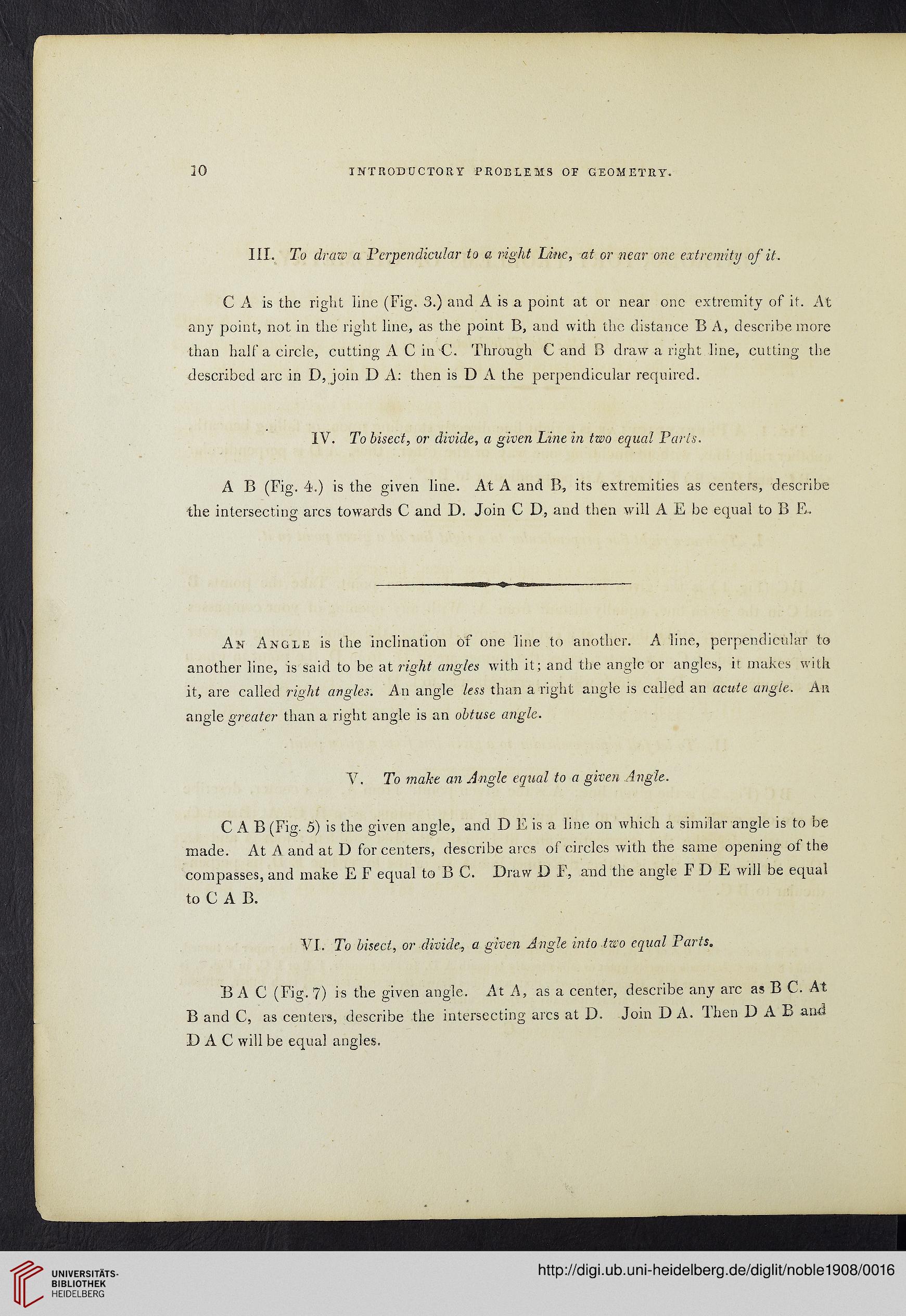30
INTRODUCTORY PROBLEMS OF GEOMETRY.
III. To dl 'aw a Perpendicular to a right Line, at or near one extremity of it.
C A is the right line (Fig. 3.) and A is a point at or near one extremity of it. At
any point, not in the right line, as the point B, and with the distance B A, describe more
than half a circle, cutting A C in C. Through C and B draw a right line, cutting the
described arc in D, join D A: then is D A the perpendicular required.
IV. To bisect, or divide, a given Line in two equal Paris.
A B (Fig. 4.) is the given line. At A and B, its extremities as centers, describe
the intersecting arcs towards C and D. Join C D, and then will A E be equal to B E.
An Angle is the inclination of one line to another. A line, perpendicular to
another line, is said to be at right angles with it; and the angle or angles, it makes with
it, are called right angles. An angle less than a right angle is called an acute angle. An
angle greater than a right angle is an obtuse angle.
Y. To make an Angle equal to a given Angle.
CAB (Fig. 5) is the given angle, and D E is a line on which a similar angle is to be
made. At A and at D for centers, describe arcs of circles with the same opening of the
compasses, and make E F equal to B C. Draw D F, and the angle E D E will be equal
to C A B.
VI. To bisect, or divide., a given Angle into two equal Parts.
B A C (Fig. 7) is the given angle. At A, as a center, describe any arc as B C. At
B and C, as centers, describe the intersecting arcs at D. Join D A. Then DAB and
D A C will be equal angles.
INTRODUCTORY PROBLEMS OF GEOMETRY.
III. To dl 'aw a Perpendicular to a right Line, at or near one extremity of it.
C A is the right line (Fig. 3.) and A is a point at or near one extremity of it. At
any point, not in the right line, as the point B, and with the distance B A, describe more
than half a circle, cutting A C in C. Through C and B draw a right line, cutting the
described arc in D, join D A: then is D A the perpendicular required.
IV. To bisect, or divide, a given Line in two equal Paris.
A B (Fig. 4.) is the given line. At A and B, its extremities as centers, describe
the intersecting arcs towards C and D. Join C D, and then will A E be equal to B E.
An Angle is the inclination of one line to another. A line, perpendicular to
another line, is said to be at right angles with it; and the angle or angles, it makes with
it, are called right angles. An angle less than a right angle is called an acute angle. An
angle greater than a right angle is an obtuse angle.
Y. To make an Angle equal to a given Angle.
CAB (Fig. 5) is the given angle, and D E is a line on which a similar angle is to be
made. At A and at D for centers, describe arcs of circles with the same opening of the
compasses, and make E F equal to B C. Draw D F, and the angle E D E will be equal
to C A B.
VI. To bisect, or divide., a given Angle into two equal Parts.
B A C (Fig. 7) is the given angle. At A, as a center, describe any arc as B C. At
B and C, as centers, describe the intersecting arcs at D. Join D A. Then DAB and
D A C will be equal angles.




